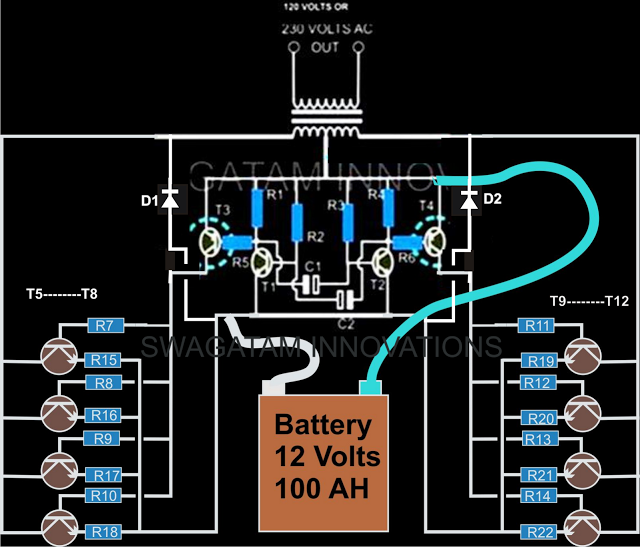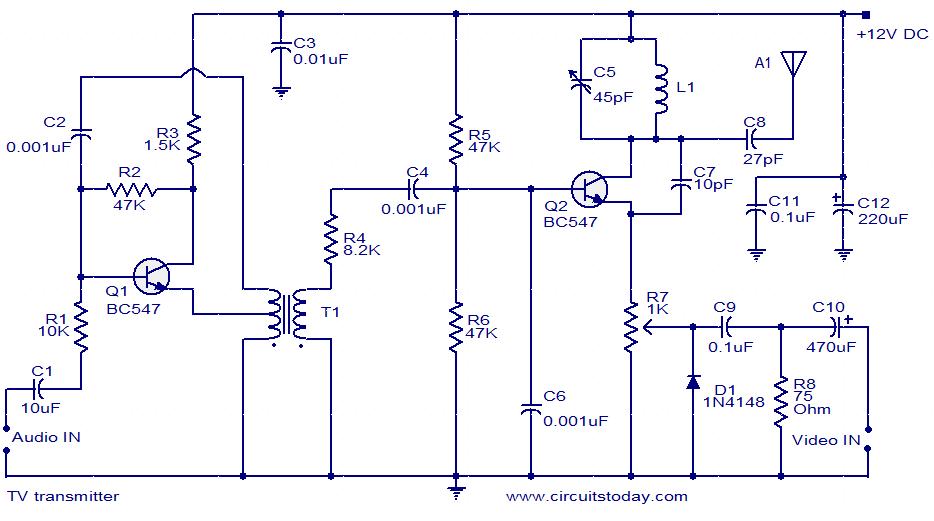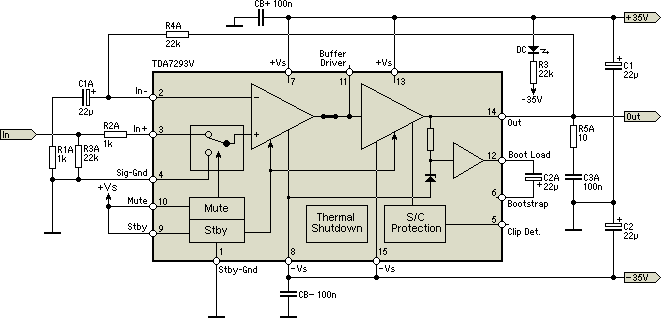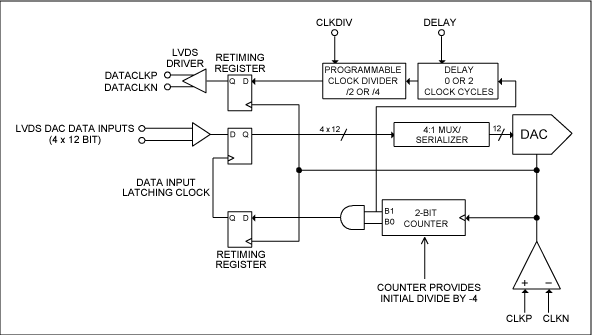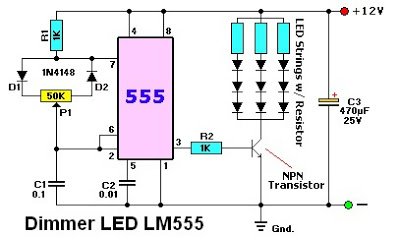
How to make an Astable or Free running Multi vibrator using 741 Op-Amp
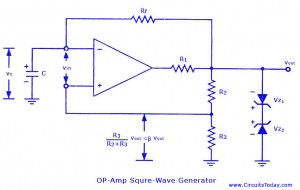
Non-sinusoidal waveform generators are also referred to as relaxation oscillators. The op-amp relaxation oscillator described is a square wave generator. Generally, square waves are relatively simple to produce. Similar to the UJT relaxation oscillator, the frequency of oscillation in this circuit is determined by the charge and discharge of a capacitor (C) through a feedback resistor (R). The core component of the oscillator is an inverting op-amp comparator, which employs positive feedback to enhance the amplifier's gain. This configuration provides two key advantages: the high gain allows the op-amp's output to switch rapidly between states, and the positive feedback introduces hysteresis into the circuit. In the op-amp square-wave generator, the output voltage (vout) is shunted to ground through two Zener diodes (Z1 and Z2) connected in reverse parallel, limiting the output voltage to either VZ1 or VZ2. A portion of the output is fed back to the non-inverting (+) input terminal. The combination of the load (IL) and capacitor (C) forms a low-pass RC circuit that integrates the output voltage (vout), with the capacitor voltage (vc) applied to the inverting input terminal instead of an external signal. The differential input voltage can be expressed as vin = vc - vout. When vin is positive, vout equals VZ1, and when vin is negative, vout equals +VZ2. At a specific moment when vin is less than 0, vout equals +VZ2, and the voltage at the non-inverting (+) input terminal equals -VZ2. The capacitor C charges exponentially towards VZ2 with a time constant of RfC. The output voltage remains at VZ2 until vc reaches -VZ2. At that point, the comparator output switches to VZ1, and vc then changes exponentially towards -VZ1, with the same time constant. This process continues, causing the output to transition from -VZ1 to +VZ2 when vc equals -VZ1. The time period (T) of the output square wave is determined by the charging and discharging behavior of capacitor C. The voltage across the capacitor (vc) during charging from -VZ to +VZ is defined by the frequency (f = 1/T) of the square wave, which remains independent of the output voltage (Vout). This circuit is also known as a free-running or astable multivibrator, as it possesses two quasi-stable states. The output stays in one state for time T1 before abruptly transitioning to the second state and remaining there for time T2. The cycle repeats after time T = (T1 + T2), where T is the square wave's time period. The op-amp square-wave generator operates effectively within the frequency range of approximately 10 Hz to 10 kHz. At higher frequencies, the op-amp's slew rate restricts the output square wave's slope. The symmetry of the output waveform is contingent on the matching characteristics of the two Zener diodes (Z1 and Z2). Asymmetrical square waves (where T1 does not equal T2) can be achieved by employing different constants for charging the capacitor C to +Vout and -Vout.
The op-amp relaxation oscillator circuit features a straightforward configuration that can be implemented with minimal components. The primary elements include an operational amplifier, two Zener diodes for voltage limiting, a feedback resistor, and a capacitor. The operational amplifier is configured in an inverting mode, where the feedback loop incorporates the Zener diodes to stabilize the output voltage levels. The feedback resistor (R) and the capacitor (C) together establish the time constant for the charging and discharging cycles, influencing the frequency of the generated square wave.
The circuit's behavior can be analyzed through its transfer function, which reflects the relationship between the input and output voltages. The integration of the output voltage by the capacitor creates a phase shift that is crucial for the oscillatory behavior. The hysteresis introduced by the positive feedback ensures that the transitions between high and low states are sharp, minimizing the risk of oscillation instability.
Furthermore, the choice of Zener diodes impacts the output voltage levels and, consequently, the symmetry of the square wave. For applications requiring precise timing or frequency characteristics, careful selection of the resistor and capacitor values is essential. The circuit can also be adapted for various applications, such as clock generation, tone generation, or signal modulation, by adjusting component values or incorporating additional circuitry. Overall, the op-amp relaxation oscillator serves as a versatile building block in waveform generation, suitable for a wide range of electronic applications.The non-sinusoidal waveform generators are also called relaxation oscillators. The op-amp relaxation oscillator shown in figure is a square wave generator. In general, square waves are relatively easy to produce. Like the UJT relaxation oscillator, the circuit`s frequency of oscillation is dependent on the charge and discharge of a capacitor C thr ough feedback resistor R, . The heart of the oscillator is an inverting op-amp comparator The compa rator uses positive feedback that increases the gain of the amplifier. In a comparator circuit this offer two advantages. First, the high gain causes the op-amp`s output to switch very quickly from one state to an other and vice-versa.
Second, the use of positive feedback gives the circuit hysteresis. In the op-amp square-wave generator circuit given in figure, the output voltage vout is shunted to ground by two Zener diodes Z1 and Z2 connected back-to-back and is limited to either VZ 2 or VZ 1. A fraction of the output is fedback to the non-inverting (+) input terminal. Combination of IL and C acting as a low-pass R-C circuit is used to integrate the output voltage vout and the capacitor voltage vc is applied to the inverting input terminal in place of external signal.
The differential input voltage is given as vin = vc - ² vout When vin is positive, vout = Vz1 and when vin is negative vout = + Vz 2. Consider an instant of time when vin < 0. At this instant vout = + Vz 2, and the voltage at the non-inverting (+) input terminal is ² Vz 2, the capacitor C charges exponentially towards Vz 2, with a time constant Rf C.
The output voltage remains constant at Vz 2 until vc equal ² Vz 2. When it happens, comparator output reverses to Vz 1. Now vc changes exponentially towards-Vz1 with the same time constant and again the output makes a transition from -Vz1 to + Vz 2. when vc equals - ²Vz 1 The time period, T, of the output square wave is determined using the charging and discharging phenomena of the capacitor C.
The voltage across the capacitor, vc when it is charging from B Vz to + Vz is given by The frequency, f = 1/T, of the square-wave is independent of output voltage Vout. This circuit is also known as free-running or astable multivibrator because it has two quasi-stable states.
The output remains in one state for time T1 and then makes an abrupt transition to the second state and re mains in that state for time T2. The cycle repeats itself after time T = (T1 + T2) where T is the time period of the square-wave. The op-amp square-wave generator is useful in the frequency range of about 10 Hz -10 kHz. At higher frequencies, the op-amp`s slew rate limits the slope of the output square wave. The symmetryof the output waveform depends on the matching of two Zener diodes Z1 and Z2. The unsymmetrical square-wave (T1 not equal to t2) can be had by using different constants for charging the capacitor C to +Vout and -Vout
🔗 External reference
The op-amp relaxation oscillator circuit features a straightforward configuration that can be implemented with minimal components. The primary elements include an operational amplifier, two Zener diodes for voltage limiting, a feedback resistor, and a capacitor. The operational amplifier is configured in an inverting mode, where the feedback loop incorporates the Zener diodes to stabilize the output voltage levels. The feedback resistor (R) and the capacitor (C) together establish the time constant for the charging and discharging cycles, influencing the frequency of the generated square wave.
The circuit's behavior can be analyzed through its transfer function, which reflects the relationship between the input and output voltages. The integration of the output voltage by the capacitor creates a phase shift that is crucial for the oscillatory behavior. The hysteresis introduced by the positive feedback ensures that the transitions between high and low states are sharp, minimizing the risk of oscillation instability.
Furthermore, the choice of Zener diodes impacts the output voltage levels and, consequently, the symmetry of the square wave. For applications requiring precise timing or frequency characteristics, careful selection of the resistor and capacitor values is essential. The circuit can also be adapted for various applications, such as clock generation, tone generation, or signal modulation, by adjusting component values or incorporating additional circuitry. Overall, the op-amp relaxation oscillator serves as a versatile building block in waveform generation, suitable for a wide range of electronic applications.The non-sinusoidal waveform generators are also called relaxation oscillators. The op-amp relaxation oscillator shown in figure is a square wave generator. In general, square waves are relatively easy to produce. Like the UJT relaxation oscillator, the circuit`s frequency of oscillation is dependent on the charge and discharge of a capacitor C thr ough feedback resistor R, . The heart of the oscillator is an inverting op-amp comparator The compa rator uses positive feedback that increases the gain of the amplifier. In a comparator circuit this offer two advantages. First, the high gain causes the op-amp`s output to switch very quickly from one state to an other and vice-versa.
Second, the use of positive feedback gives the circuit hysteresis. In the op-amp square-wave generator circuit given in figure, the output voltage vout is shunted to ground by two Zener diodes Z1 and Z2 connected back-to-back and is limited to either VZ 2 or VZ 1. A fraction of the output is fedback to the non-inverting (+) input terminal. Combination of IL and C acting as a low-pass R-C circuit is used to integrate the output voltage vout and the capacitor voltage vc is applied to the inverting input terminal in place of external signal.
The differential input voltage is given as vin = vc - ² vout When vin is positive, vout = Vz1 and when vin is negative vout = + Vz 2. Consider an instant of time when vin < 0. At this instant vout = + Vz 2, and the voltage at the non-inverting (+) input terminal is ² Vz 2, the capacitor C charges exponentially towards Vz 2, with a time constant Rf C.
The output voltage remains constant at Vz 2 until vc equal ² Vz 2. When it happens, comparator output reverses to Vz 1. Now vc changes exponentially towards-Vz1 with the same time constant and again the output makes a transition from -Vz1 to + Vz 2. when vc equals - ²Vz 1 The time period, T, of the output square wave is determined using the charging and discharging phenomena of the capacitor C.
The voltage across the capacitor, vc when it is charging from B Vz to + Vz is given by The frequency, f = 1/T, of the square-wave is independent of output voltage Vout. This circuit is also known as free-running or astable multivibrator because it has two quasi-stable states.
The output remains in one state for time T1 and then makes an abrupt transition to the second state and re mains in that state for time T2. The cycle repeats itself after time T = (T1 + T2) where T is the time period of the square-wave. The op-amp square-wave generator is useful in the frequency range of about 10 Hz -10 kHz. At higher frequencies, the op-amp`s slew rate limits the slope of the output square wave. The symmetryof the output waveform depends on the matching of two Zener diodes Z1 and Z2. The unsymmetrical square-wave (T1 not equal to t2) can be had by using different constants for charging the capacitor C to +Vout and -Vout
🔗 External reference
